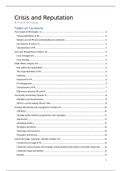Crisis and Reputation
By Pascale den Hartog
Table of Contents
The Context of PR (chapter 1)................................................................................................................2
Various definitions of PR:...................................................................................................................2
Debates around PR and understanding its complexity.......................................................................3
Key features of history in....................................................................................................................3
Characteristics of PR...........................................................................................................................3
Issue and Management (chapter 16)......................................................................................................4
Issue management.............................................................................................................................4
Issue strategy......................................................................................................................................4
Public Afairs (chapter 20)......................................................................................................................6
Role within the organisation...............................................................................................................6
The scope/definition of PA.................................................................................................................6
Lobbying.............................................................................................................................................6
Important for PA.................................................................................................................................6
PA Management.................................................................................................................................6
Characteristics of PA...........................................................................................................................7
Diferences between PR and PA.........................................................................................................7
Community and Society (chapter 4).......................................................................................................8
Definition and characteristics.............................................................................................................8
Stone in a pond analogy (Peach, CSR).................................................................................................8
Strategic PR planning and management (chapter 8)............................................................................10
STEEPLED..........................................................................................................................................10
Strategic public relations programmes and campaigns....................................................................11
Approaches.......................................................................................................................................12
Identifying Publics............................................................................................................................12
Strategies and tactics:.......................................................................................................................12
Timescales and resources.................................................................................................................13
Evaluation and Review......................................................................................................................13
Corporate image, reputation, identity (chapter 10).............................................................................14
Controversy of image in PR...............................................................................................................14
Corporate communication and strategic communication (both lead to favourable imag/rep)........14
Corporate Image and Identity...........................................................................................................14
Identity:............................................................................................................................................15
1
, Image <> reputation.........................................................................................................................15
Media relations.....................................................................................................................................16
Media Relations................................................................................................................................16
PR vs. Publicity..................................................................................................................................16
Media relations theories...................................................................................................................16
The Context of PR (chapter 1)
Various defnitions of PR:
The management of communication between an organisation and its publics and an
organisationns managed communications behaviour
Communication with various publics
Public relations is the management function that establishes and maintains mutually benefi
cial relationships between an organisation and the publics on whom its success or failure
depends
PR is ofen a synonym for deception, or ‘spinn, and that everyday understanding of PR is
usually determined by the visible results of PR activity
Competitive communication seeking advantage for its principals and using many promotional
techniques, visible and invisible, outside of paid advertising
Defines PR as a ‘social and organisational forcen, as a profession through which the identities
of practitioners and their clients are constructed, and as a set of ‘complex relationships by
2
, which interests and self-interests are enacted through structures, functions and shared
meanings
PR is the fow of purposive communication produced on behalf of individuals, formally
constituted and informally constituted groups, through their continuous trans-actions with
other social entities. It has social, cultural, political and economic ef ects at local, national
and global levels
Debates around PR and understanding its complexity
Collective View: issues that emerge through rational discussion in the population (obesity =
result of poor nutrition)
Aggregate View: refers to sum of individual opinions of the population governed by the
democratic state – what the majority says (i.e. through polls, voting etc.)
Debates: who is included in the term publics? To what extend does the rational debate in the
collective view take place? Does everyone have equal access to debate? Where do minorities
express their opinion?
Complexity: mass media, rapid growing media industries, fast information technology ?
Key features of history in
Great Britaiin British empire, colonies, printed media, advent of film, later by government,
wartime propaganda, infuence of public sector bureaucracy -> Chartered Institute of Public
Relations (CIPR, IPR) heavily infuenced the development of the profession
Germaiyn industrialization, new technology, changing political environment, propaganda by
Nazis urbanisation, East (more underdeveloped because restricted media) vs. West (more
fourishing)
USAn War of Independence (slogans, events, agenda setng), rapidly expanding newspaper
industry, telegraph, communication used to be not ongoing but only in crisis, consumerism
Characteristics of PR
(Extension of marketing department)
Commercialisation (making money) > profit
Long term
Enhancing the image of the organisation
Tends to use methods of promotion, that convey a possitive image of the organisation
Corporate setng > selling products
Its a product of the cultural, political, economic circumstances, so itns constantly evolving
Itns used by a wide range of organisations in diferent ways (diferent meaning)> the audience
is diferent so the goal is diferent as wel
3





